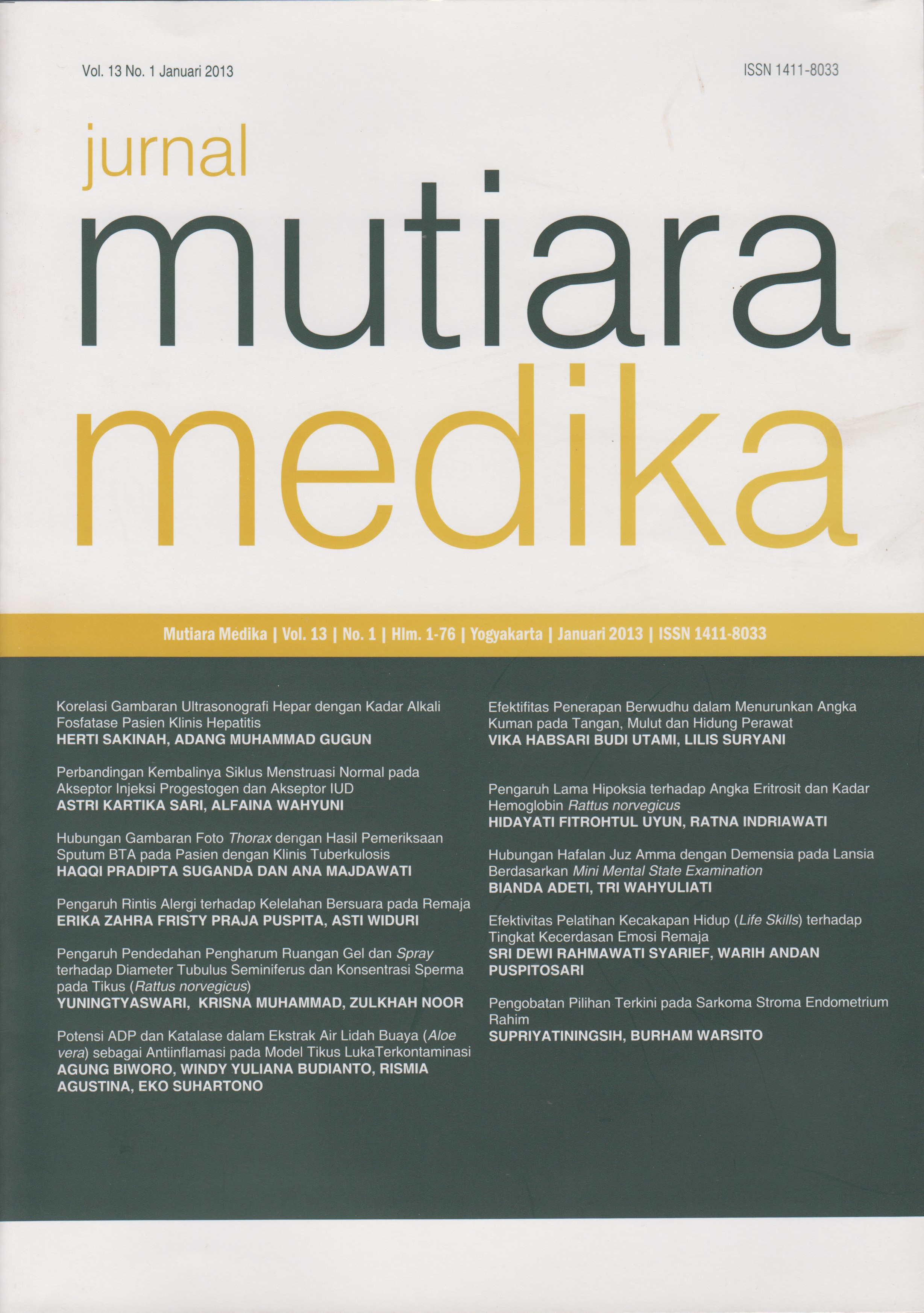Perbandingan Kembalinya Siklus Menstruasi Normal pada Akseptor Injeksi Progestogen dan Akseptor IUD
DOI:
https://doi.org/10.18196/mmjkk.v13i1.1050Keywords:
kembalinya siklus menstruasi normal, injeksi progestogen, IUD, return of normal menstruation cycle, progestogen injectionAbstract
Jumlah populasi di Indonesia mengalami peningkatan yang sangat signifikan setiap tahunnya. Pemerintah membuat kebijakan mengenai perencanaan keluarga atau yang disebut dengan Keluarga Berencana (KB) untuk menanggulangi jumlah penduduk. Penelitian ini bertujuan untuk mengetahui perbandingan kecepatan kembalinya siklus menstruasi normal pada akseptor injeksi progestogen dan akseptor IUD. Jenis penelitian ini adalah deskriptif analitik menggunakan desain cross sectional. Pengumpulan data dilakukan dengan melakukan wawancara pada 81 akseptor IUD dan 81 akseptor injeksi progestogen 3 bulanan di Puskesmas Kedungwuni I Kabupaten Pekalongan. Setiap ibu diberi pertanyaan yang sama mengenai identitas diri, metode KB yang digunakan, tahun awal pemakaian metode tersebut, lama pemakaian, siklus menstruasi pasca penghentian metode KB dan parietas. Analisis data menggunakan independent T test. Selain itu, sebagai data sekunder, peneliti juga mencari pengaruh antara lama pemakaian dengan kembalinya siklus menstruasi pada masing-masing metode KB dengan menggunakan uji korelasi Pearson. Hasil penelitian menunjukkan kembalinya siklus menstruasi normal pada akseptor IUD lebih cepat 3 bulan dibandingkan dengan akseptor injeksi progestogen (P=0.000; CI=95%) dengan waktu kembali rata-rata 1.02±0.16 bulan. Rata-rata waktu kembalinya siklus menstruasi normal pada akseptor injeksi progestogen adalah 7.43±3.73 bulan. Disimpulkan bahwa tidak terdapat pengaruh lama pemakaian dengan kecepatan kembalinya siklus menstruasi pada akseptor injeksi progestogen dan akseptor IUD.
The amount of Indonesia population is getting significantly increase every year. The government made a policy about family planning or Keluarga Berencana (KB) to overcome the population. This research aims to know the comparison normal menstruation cycle return in progestogen injection acceptor and IUD’s acceptor. This is a descriptive analysis research with cross sectional design by doing an interview with 81 IUD’s acceptors and 81 progestogen injection’s acceptors in work area of Puskesmas Kedungwuni I Pekalongan regency. Every acceptor was given the same questions such as identity, contraceptive method, year when she start using that method, the duration of use, her normal menstruation cycle after stop the method, and parity. The data analyzed using independent T test. In addition, as secondary result, researcher also looking for the impact of duration of use and the return of normal menstruation cycle in both of the method by using bivariate Pearson correlation. The result showed that the return of normal menstruation cycle of IUD’s acceptors is faster than progestogen injection’s acceptor (P=0.000; CI=95%) with 1.02±0.16 month on an average, and 7.43±3.73 months in progestogen injection’s acceptors. It can concluded that duration of use has no impact on return of normal menstruation cycle in progestogen injection acceptor and IUD’s acceptor.
References
Badan Kependudukan dan Keluarga Berencana Nasional. Prediksi Pertumbuhan Penduduk Meleset, BKKBN Genjot KB. 2012. Diakses tanggal 28 Maret 2012 dari http://www.bkkbn.go.id/berita/Pages/PrediksiPertumbuhan-Penduduk-Meleset,-BKKBNGenjot-KB.aspx
Manuaba, IBG. Operasi Kebidanan, Kandungan dan Keluarga Berencana untuk Dokter Umum (Edisi 1). Jakarta: EGC. 1999.
Llewellyn, D. Dasar-dasar Obstetri dan Ginekologi (Edisi 6) (Hadyanto, penerjemah). Jakarta: Hipokrates. 2001.
Departemen Kesehatan Republik Indonesia. Profil Kesehatan Provinsi Kepulauan Riau 2006 . Tanjung Pinang. 2006.
Panuntun, S., Wilopo, SA., Kurniawati, L. Juni. Hubungan antara Akses KB dengan Pemilihan Kontrasepsi Hormonal dan Non Hormonal di Kabupaten Purworejo. Berita Kedokteran Masyarakat, 2009; 25: 88-95.
Hacker, N., Moore, JG. Esensial Obstetri dan Ginekologi (ed.2). Jakarta: Hipokrates. 2001.
Saifuddin, AB., Affandi, B., Baharuddin, M., Soekir, S. Buku Panduan Praktis Pelayanan Kontrasepsi (ed.2.). Jakarta: ayasan Bina Pustaka Sarwono Prawirohardjo. 2010.
Scott, J.R., Gibbs, R.S., Karlan, B.Y., Haney, A.F. Danforth’s Obstetrics and Gynecology (9th ed.). Philadelphia: Lippincott Williams & Wilkins. 2003.
Firley, D.H. Lecture Notes on Obstetric and Gynaecology (2nd ed.). Massachusetts: Blackwell. 2004.
American Collage of Obstetricians and Gynecologist. Tool Kit for Teen Care (2nd ed). Washington. 2010.
Oriowo MA, Landgren BM, Stenström B, Diczfalusy E.. A Comparison of the Pharmacokinetic Properties of Three Estradiol Esters. Contraception. 1980; 21 (4): 415-24.
Miller, A.W.F. & Callander, R. Obtetrics Ilustrated (4th ed).New York: Churchill Livingstone Inc. 1989.
Manuaba, IBG. Kapita Selekta Penatalaksanaan Rutin Obstetri Ginekologi dan KB. Jakarta: EGC. 2001.
Downloads
Published
Issue
Section
License
Copyright
Authors retain copyright and grant Mutiara Medika: Jurnal Kedokteran dan Kesehatan (MMJKK) the right of first publication with the work simultaneously licensed under an Attribution 4.0 International (CC BY 4.0) that allows others to remix, adapt and build upon the work with an acknowledgment of the work's authorship and of the initial publication in Mutiara Medika: Jurnal Kedokteran dan Kesehatan (MMJKK).
Authors are permitted to copy and redistribute the journal's published version of the work (e.g., post it to an institutional repository or publish it in a book), with an acknowledgment of its initial publication in Mutiara Medika: Jurnal Kedokteran dan Kesehatan (MMJKK).
License
Articles published in the Mutiara Medika: Jurnal Kedokteran dan Kesehatan (MMJKK) are licensed under an Attribution 4.0 International (CC BY 4.0) license. You are free to:
- Share — copy and redistribute the material in any medium or format.
- Adapt — remix, transform, and build upon the material for any purpose, even commercially.
This license is acceptable for Free Cultural Works. The licensor cannot revoke these freedoms as long as you follow the license terms. Under the following terms:
Attribution — You must give appropriate credit, provide a link to the license, and indicate if changes were made. You may do so in any reasonable manner, but not in any way that suggests the licensor endorses you or your use.
- No additional restrictions — You may not apply legal terms or technological measures that legally restrict others from doing anything the license permits.






